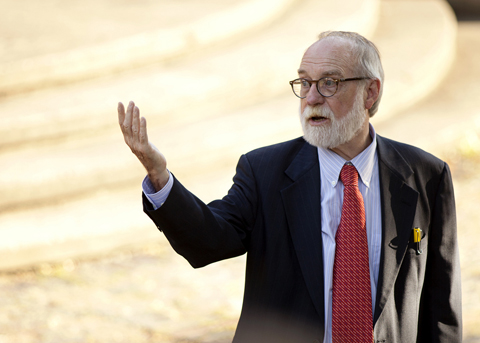If it had signed the various international human rights treaties put forth since two world wars dominated the 20th century world stage, “the United States would be a more generous nation today.”
Yet many of the countries that did sign the treaties haven’t enforced them, continued Bert B. Lockwood, Director of the Urban Morgan Institute for Human Rights at the University of Cincinnati Law School and editor-in-chief of Human Rights Quarterly.
Lockwood narrated the profound relationships between U.S. constitutional law and international human rights law in his Constitution Day lecture to an overflow crowd of more than 200 students and faculty.
Fears about National Sovereignty
It was the international human rights discussions that arose after the war to end all wars that not just helped undermine the League of Nations with fears about national sovereignty—but also launched a powerful international dialogue that continues today.
Lockwood wove together a series of themes—U.S. constitutional law, the founding events of U.S. history, and major political milestones of the 20th century.
Speaking from a podium in the open-air Scripps auditorium, he took the audience back to the time of the Allied victory in the European Theater during World War II.
Around the table: Winston Churchill, with a commitment to maintaining Great Britain’s colonial empire; Franklin Delano Roosevelt, with a nation unwelcoming, and worse, to its returning segregated troops; and Joseph Stalin, with millions in labor camps and hundreds of thousands executed. It was China, whose people had been enslaved and brutalized by Japan in the Pacific Theater, which pushed for the international human rights treaty.
When the United Nations discussion arrived in San Francisco in 1945, a host of non-governmental organizations continued to push for a human rights treaty and an emphasis on human rights in the United Nations charter.
The UN Charter and the Human Rights Declaration
Roosevelt had a problem—a Senate led by Southern Democrats who were separatists. A Senate that the U.S. Constitution said must vote on all treaties, with a two-thirds vote required for approval. John Foster Dulles, who would later serve as Secretary of State under Dwight Eisenhower, came up with the solution, Lockwood said.
Into Article II of the UN Charter in 1945 went language that said the United Nations could not interfere in domestic matters of member nations—“Nothing contained in the present Charter shall authorize the United Nations to intervene in matters which are essentially within the domestic jurisdiction of any state….” The Universal Declaration of Human Rights would follow several years later.
“The Universal Declaration of Human Rights, which was adopted by the UN General Assembly on 10 December 1948, was the result of the experience of the Second World War. With the end of that war, and the creation of the United Nations, the international community vowed never again to allow atrocities like those of that conflict happen again. World leaders decided to complement the UN Charter with a road map to guarantee the rights of every individual everywhere,” according to the UN website.
‘A Bold Decision, Never Enforced’
The result, Lockwood said, was “a bold declaration about human rights and freedoms” and a U.N. charter that “made sure they would not be enforced.”
As Lockwood explained, Roosevelt appointed Eleanor Roosevelt to chair the United Nations Human Rights Commission in order “to define what do you mean by fundamental freedom. She played a key role in the universal declaration of human rights. She included our own Bill of Rights plus articles about standard of living rights.” He noted, “it recognized that if you don’t have your basic needs met, then other rights pale by comparison.”
For example, Article 25 of the Human Rights Declaration says, “Everyone has the right to a standard of living adequate for the health and well-being of himself and of his family, including food, clothing, housing and medical care and necessary social services, and the right to security in the event of unemployment, sickness, disability, widowhood, old age or other lack of livelihood in circumstances beyond his control.”
While the spirit of protection for social, economic, and cultural rights has made limited inroads in the United States, Lockwood said that only one part of the Declaration made it into U.S. law, and that one exception was enormously expensive—the GI Bill of Rights, providing benefits for veterans returning home from World War II.
Brown v. Board of Education
When it came to Brown v. Board of Education, Lockwood argued, “the United Nations human rights charter played an uncredited role.”
“It would not have been permissible for the court to say our constitution won’t deal with this situation, but we can rely on this United Nations treaty,” Lockwood noted, given that the United States had engineered the Article II language whereby a nation’s domestic laws took precedence over the UN’s charter.
“So the Supreme Court reinterprets due process under the 5th Amendment and equal protection under the 14th Amendment. It reads them differently,” said Lockwood, who authored a chapter on “Toward the Economic Brown: Economic Rights in the United States and the Possible Contribution of International Human Rights Law” in the book World Justice? U.S. Courts and International Human Rights (Westview, 1991).
By Lori Bauer
Director of Communications, College of Arts & Sciences, Ohio University
Photos by Katelyn Preston ’14




















One Comment